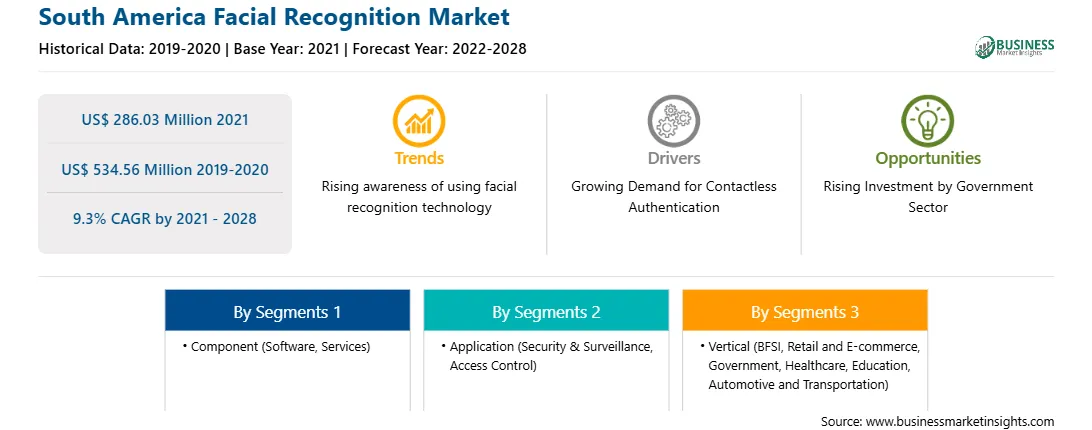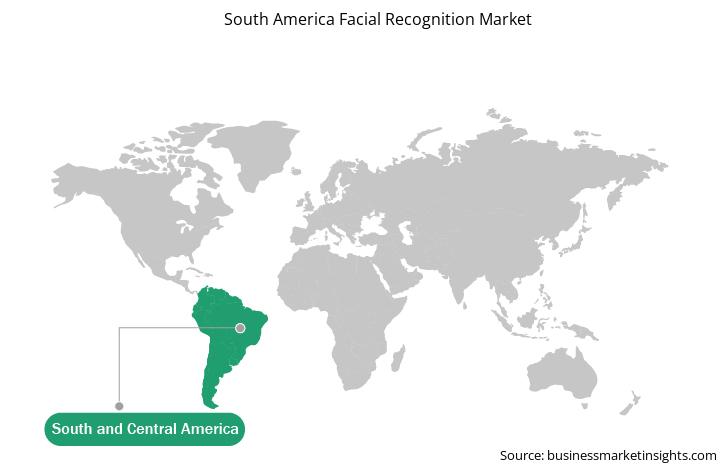3D face recognition systems deliver more accurate results than their 2D counterparts by measuring the geometry of rigid facial features. 3D face recognition systems could accurately recognize human faces even under dim lights. With varying facial positions and expressions, 2D face recognition systems face difficulties while operating in such conditions. The 3D face recognition technique uses sensors that help capture 3D face images and track persons’ faces in real time with improved precision; moreover, these systems identify an individual irrespective of variations in their poses and expressions, and lighting conditions. Owing to the higher accuracy of 3D facial recognition systems, their deployment is on the rise in public safety systems at airports, and border protection and surveillance check posts. Thus, with the growing research and development efforts, 3D recognition systems are leading to significant future trends in the facial recognition market.
Strategic insights for the South America Facial Recognition provides data-driven analysis of the industry landscape, including current trends, key players, and regional nuances. These insights offer actionable recommendations, enabling readers to differentiate themselves from competitors by identifying untapped segments or developing unique value propositions. Leveraging data analytics, these insights help industry players anticipate the market shifts, whether investors, manufacturers, or other stakeholders. A future-oriented perspective is essential, helping stakeholders anticipate market shifts and position themselves for long-term success in this dynamic region. Ultimately, effective strategic insights empower readers to make informed decisions that drive profitability and achieve their business objectives within the market.

| Report Attribute | Details |
|---|---|
| Market size in 2021 | US$ 286.03 Million |
| Market Size by 2028 | US$ 534.56 Million |
| Global CAGR (2021 - 2028) | 9.3% |
| Historical Data | 2019-2020 |
| Forecast period | 2022-2028 |
| Segments Covered |
By Component
|
| Regions and Countries Covered | South and Central America
|
| Market leaders and key company profiles |
The geographic scope of the South America Facial Recognition refers to the specific areas in which a business operates and competes. Understanding local distinctions, such as diverse consumer preferences (e.g., demand for specific plug types or battery backup durations), varying economic conditions, and regulatory environments, is crucial for tailoring strategies to specific markets. Businesses can expand their reach by identifying underserved areas or adapting their offerings to meet local demands. A clear market focus allows for more effective resource allocation, targeted marketing campaigns, and better positioning against local competitors, ultimately driving growth in those targeted areas.

The South America facial recognition market is segmented on the basis of component, application, vertical, and country. Based on component, the market is segmented into software and services. In 2020, the software segment held a larger market share. The market for the software segment is further segmented into 2D facial recognition, 3D facial recognition, and facial analytics. In 2020, the 3D facial recognition segment held the largest market share. The market for the services segment is subsegmented into training & consulting, integration and implementation, and support & maintenance. In 2020, the integration and implementation segment held the largest share of the market. Based on application, the South America facial recognition market is segmented into security & surveillance, access control, and others. In 2020, the security & surveillance segment held the largest market share. Based on vertical, the market is segmented into BFSI, retail and e-commerce, government, healthcare, education, automotive and transportation, and others. In 2020, the government segment held the largest market share. Aware Inc., Fujitsu Limited, IDEMIA, NEC Corporation, and Thales Group are among the leading companies in the South America facial recognition market.
The South America Facial Recognition Market is valued at US$ 286.03 Million in 2021, it is projected to reach US$ 534.56 Million by 2028.
As per our report South America Facial Recognition Market, the market size is valued at US$ 286.03 Million in 2021, projecting it to reach US$ 534.56 Million by 2028. This translates to a CAGR of approximately 9.3% during the forecast period.
The South America Facial Recognition Market report typically cover these key segments-
The historic period, base year, and forecast period can vary slightly depending on the specific market research report. However, for the South America Facial Recognition Market report:
The South America Facial Recognition Market is populated by several key players, each contributing to its growth and innovation. Some of the major players include:
The South America Facial Recognition Market report is valuable for diverse stakeholders, including:
Essentially, anyone involved in or considering involvement in the South America Facial Recognition Market value chain can benefit from the information contained in a comprehensive market report.